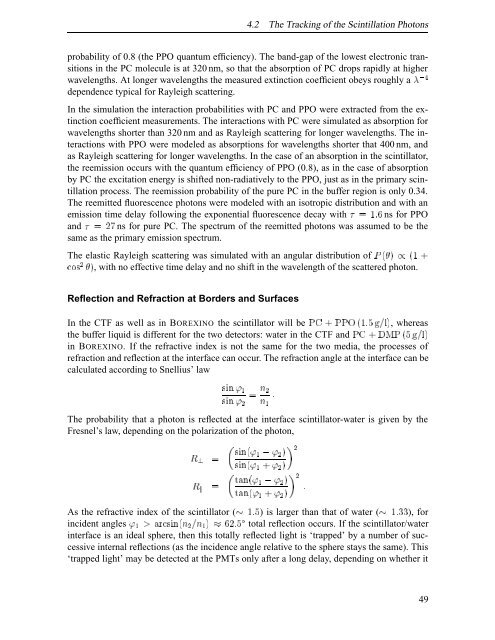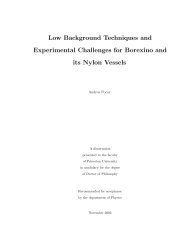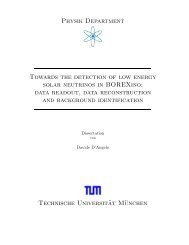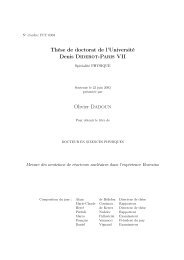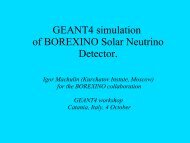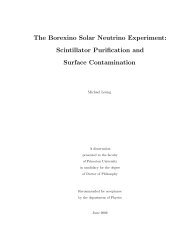Development of a Liquid Scintillator and of Data ... - Borexino - Infn
Development of a Liquid Scintillator and of Data ... - Borexino - Infn
Development of a Liquid Scintillator and of Data ... - Borexino - Infn
Create successful ePaper yourself
Turn your PDF publications into a flip-book with our unique Google optimized e-Paper software.
4.2 The Tracking <strong>of</strong> the Scintillation Photons<br />
probability <strong>of</strong> 0.8 (the PPO quantum efficiency). The b<strong>and</strong>-gap <strong>of</strong> the lowest electronic transitions<br />
in the PC molecule is at 320 nm, so that the absorption <strong>of</strong> PC drops rapidly at higher<br />
wavelengths. At longer wavelengths the measured extinction coefficient obeys roughly a <br />
dependence typical for Rayleigh scattering.<br />
In the simulation the interaction probabilities with PC <strong>and</strong> PPO were extracted from the extinction<br />
coefficient measurements. The interactions with PC were simulated as absorption for<br />
wavelengths shorter than 320 nm <strong>and</strong> as Rayleigh scattering for longer wavelengths. The interactions<br />
with PPO were modeled as absorptions for wavelengths shorter that 400 nm, <strong>and</strong><br />
as Rayleigh scattering for longer wavelengths. In the case <strong>of</strong> an absorption in the scintillator,<br />
the reemission occurs with the quantum efficiency <strong>of</strong> PPO (0.8), as in the case <strong>of</strong> absorption<br />
by PC the excitation energy is shifted non-radiatively to the PPO, just as in the primary scintillation<br />
process. The reemission probability <strong>of</strong> the pure PC in the buffer region is only 0.34.<br />
The reemitted fluorescence photons were modeled with an isotropic distribution <strong>and</strong> with an<br />
emission time delay following the exponential fluorescence decay with ns for PPO<br />
<strong>and</strong> ns for pure PC. The spectrum <strong>of</strong> the reemitted photons was assumed to be the<br />
same as the primary emission spectrum.<br />
The elastic Rayleigh scattering was simulated with an angular distribution <strong>of</strong> È <br />
Ó× , with no effective time delay <strong>and</strong> no shift in the wavelength <strong>of</strong> the scattered photon.<br />
Reflection <strong>and</strong> Refraction at Borders <strong>and</strong> Surfaces<br />
In the CTF as well as in BOREXINO the scintillator will be È ÈÈÇ Ð , whereas<br />
the buffer liquid is different for the two detectors: water in the CTF <strong>and</strong> È ÅÈ Ð<br />
in BOREXINO. If the refractive index is not the same for the two media, the processes <strong>of</strong><br />
refraction <strong>and</strong> reflection at the interface can occur. The refraction angle at the interface can be<br />
calculated according to Snellius’ law<br />
×Ò<br />
×Ò<br />
Ò<br />
Ò <br />
The probability that a photon is reflected at the interface scintillator-water is given by the<br />
Fresnel’s law, depending on the polarization <strong>of</strong> the photon,<br />
<br />
×Ò<br />
Ê <br />
Ê <br />
×Ò<br />
<br />
ØÒ<br />
ØÒ<br />
As the refractive index <strong>of</strong> the scintillator ( ) is larger than that <strong>of</strong> water ( ), for<br />
incident angles Ö ×Ò Ò Ò Æ total reflection occurs. If the scintillator/water<br />
interface is an ideal sphere, then this totally reflected light is ‘trapped’ by a number <strong>of</strong> successive<br />
internal reflections (as the incidence angle relative to the sphere stays the same). This<br />
‘trapped light’ may be detected at the PMTs only after a long delay, depending on whether it<br />
<br />
49


